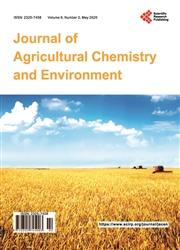Decay Resistance of Particleboards Manufactured with Four Agro-Forest Residues Using Cassava Starch and Urea Formaldehyde as Adhesives
引用次数: 0
Abstract
Many factors including depletion of the forest, environmental awareness, and generation of large quantities of agro-forest residues have increased the need to partially or wholly replace wood with agro-forest residue for particleboard production. This study assessed the decay resistance of particleboards produced from four agro-forest residues using cassava starch and urea formaldehyde as adhesives. Musa paradisiaca pseudostem, Theobroma cacao stem and pod, and sawdust of Ceiba pentandra were used for the study. Properties determined were: Weight loss, decay resistance rating and decay susceptibility index. These properties were evaluated after 12 weeks of exposure to Coriolopsis polyzona in accordance with ASTM D 2017-05. The results indicate that the weight loss for Musa paradisiaca pseudostem particleboard was least for both urea formaldehyde and cassava starch adhesives. Even though almost all the particleboards produced were classified as resistant or highly resistant to fungi attack, those produced with urea formaldehyde had better decay resistance properties than that of cassava starch. Furthermore, particleboards coated with synthetic polyvinyl lacquer had better resistance to fungi attack than the uncoated ones. At 5% level of significance, the agro-forest residue, adhesive and surface finish as well as their interactions had significant effects on decay resistance of the particleboards produced. It is recommended that further studies which aim at determining the effect of combination of the agro-forest residues and that of urea formaldehyde and cassava starch be conducted to determine their effects on decay properties of particleboards.木薯淀粉和脲醛为胶粘剂的四种农林废弃物刨花板的耐腐性
许多因素,包括森林的枯竭、环境意识和大量农林残余物的产生,增加了用农林残余物部分或全部取代木材用于刨花板生产的必要性。本研究以木薯淀粉和脲醛为粘合剂,评估了四种农林废弃物生产的刨花板的耐腐性。本研究使用了拟木犀茎、可可茎和荚以及Ceiba penandra的木屑。测定的特性为:重量损失、耐衰变等级和衰变敏感性指数。根据ASTM D 2017-05,在暴露于多带Coriolopsis 12周后评估这些特性。结果表明,脲醛和木薯淀粉两种胶粘剂对木麻黄假茎刨花板的失重最小。尽管几乎所有生产的刨花板都被归类为耐真菌或高度耐真菌侵袭,但用脲醛生产的刨花板比木薯淀粉具有更好的耐腐烂性能。此外,与未涂覆的刨花板相比,涂覆合成聚乙烯漆的刨花板具有更好的抗真菌侵袭性。在5%的显著性水平上,农林废弃物、粘合剂和表面光洁度及其相互作用对生产的刨花板的耐腐性有显著影响。建议进行进一步的研究,以确定农林残余物与脲醛和木薯淀粉的组合对刨花板腐烂性能的影响。
本文章由计算机程序翻译,如有差异,请以英文原文为准。
求助全文
约1分钟内获得全文
求助全文

 求助内容:
求助内容: 应助结果提醒方式:
应助结果提醒方式:


